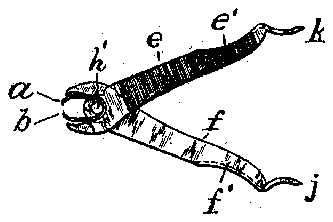
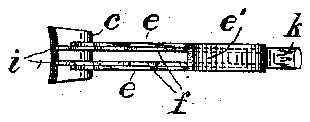
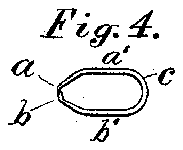
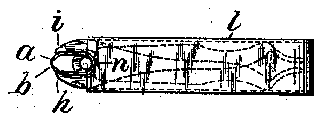
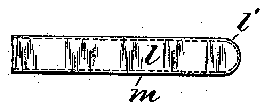
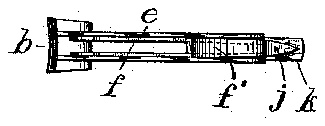


- 71fingers
Description
No. 806,037. PATENTEDNOV. 28, 190.5.
K H. WILcoX.
NAIL oL-IPPER 0R WIRE GUTTER.
APPLICATION FILED NOV. 16. 1904.
Zef: Y A fafa/venan NHVNITED STATES HENRY wincox, E NEWARK, NEW JERSEY.
. NAIL-CLIPPER on wins-CUTTER.
. clipper in which the jaws are formed in one PATENT OFFICE.
Patented Nov. as, 1905.
' Application led November 16, 1904. Serial No. 232,938.
Jb all whomv it muy concern:
'pers or Wire-'Cutters fully described and represented in the following speciiication and the accompanying drawings, forming a part of the same.
The present invention relates to a nailpiece of sheet-metal with two arms connected by a loop, and the invention furnishes an improved construction -for the hand-levers, for the means of pivoting them to the loop, for
the means `of engaging the outer sides of thel loop to press the jaws together, and for the means of holding the jaws and the hand-levers together for transportation.
In the present invention 'the loop of the cutters is notched and the hand-levers are provided with side vplates which are fitted to the notches and are provided with pivotholes to receive a pin within the loop. The hand-levers are provided with fingers which extend over the outer sides of the loop to press the jaws` together, and the hand-levers are unprovided with any means for locking them together when closed; but a casing is provided which can be slipped over the handlevers to confine and inclose the same for transportation. Each handlever is made with two at plates which may be formed integral with the finger-plate by stamping from a single blank.
The invention will be understood by reference to the annexed drawings, in which- Figure 1 is a side View of a nail-clipper embodying the improvements with the levers separated. Fig. 2 is a view of the upper side of the clipper shown in Fig. l. Fig. 3 is a plan of the jaw-piece. Fig. 4 is an end view of the same doubly enlarged to show the operation of the shearing-jaws more clearly. Fig. 5 is a side view of the same clipper with the hand-levers and jaws closed and the handlevers inclosed in a casing. Fig. 6 is an edge view of the same casing detached V'from the clipper. Fig. 7 is a view of the under side of the clipper shown in Fig. 1. Fig. 8 shows the blank from which one of the hand-levers is formed. Fig. 9 is a view like Fig. 4, showing jaws for clipping wire or metal; and Fig. 10 shows a blank for the integral jaw-piece.
each hand-lever.
'a and b designate the cutting-jaws, formed l upon the ends of armsct' and In", which are integral with one another and connected by the curved loop c. The loop lis so formed as to hold the jaws normally separated, as shown in Fig. 1,.and is shown in Fig. 3 provided with notches d, in which lugs g upon the handlevers are inserted and jointed upon a pivot pin or wire h', which is extended through the loop and the holes g in the lugs. (See Fig. 8.) The hand-levers are formed, respectively,
with side plates e and f, which are connected f together near their rear ends by finger-platesy e and f such plates being extended in the rear of the side plates to form, respectively, a nail-cleaner j and a quick loosener 7n.
The quick-loosener, as shown in Figs. 1 and 2, consists of a fiat blade with its end rounded and beveled' into chisel shape and adapted to force under the nail-quick to-loosen the same from the linger-nail. The side plates e are provided with ngers t and the side plates f with fingers e', which extend forwardly from the lugs g upon the outer sides of the jaw-arms a and' t and are shaped, as shown in Fig. 5, to press the jaws into operative relation when the hand-levers are closed or pressed together. rlhe hand-levers, having each .two side plates and a finger-plate, are readily formed from a single blank of sheet metal, like that-shown in Fig. 8, where the parts of the blank are provided with letters corresponding to the same parts in Figs. 1 and 2, which parts are bent upon thelines :r m in Fig. 8 to give the shape shown in the other lfigures. The side plates and finger-plate are shown integral in The jaw-blank (shown in Fig. 10) is also readily made of sheet metal, with slots stamped therein for the notches 0l, and the armsa and b at opposite ends of the blank may be bent to form shearing-cutters, as shown in Figs. 1, 2,- and 4, or to form cutters of similar shape opposed to one another or clipping sheet metal or wire, as shown in Although blanks made of sheet'metal are shown in the drawings, it is evident that the hand-levers for operating the jawsmay be constructed of other material provided they are formed to engage notches in the cutterloop and are provided with the fingers It and i extended upon the outer sides of the loop to press the jaws together.
With the particular construction shown in the drawings a pair of jaws can be readily re- IOO moved from the lever b y drawing the pivotpin and another pair of jaws substituted therefor, and the cutting-jaws may thus be entirely renewed at a very slight expense. SuchV substitution permits the same handlevers to be used at one time with shearingjaws, such as are shown in Fig. 4C, and at another time with wire-cutters, such as are shown in Fig. 9.
Having thus set forth the invention, what is claimed herein is- 1. A clipper having the two jaws formed in one piece of sheet metal with an elastic loop, a pivot inserted in the loop and two hand-levers jointed upon the pivot and provided respectively with the fingers /t and t' extended over the outer sides of the loop for closing the jaws.
2. A clipper having the two jaws formed in one piece of sheet metal with an elastic loop and the loop notchedV to admit pivot-lugs, a pivot inserted in the loop, hand-levers having pivot-lugs fitted to the notches and jointed upon the pivot, and provided respectively with the fingers 71. and t' for closing the jaws.
3. A clipper having the two jaws formed in one piece of sheet metal, with an elastic loop, the loop having two notches formed transversely of the loop and a pivot inserted in the loop, and a pair of hand-levers each having two side plates united by an integral [ingerplate, and such side plates provided with lugs inserted in the notches and jointed upon the pivot, and with the fingers /L and 11 extended outside of the jaws for closing the same.
4. A nail-clipper having two jaws formed in one piece of sheet metal with an elastic loop, a pivot inserted in the loop, hand-levers jointed upon the pivot and the jaws and handlevers pressed normally apart by the 'elasticity of the loop, and the casing constructed as described and adapte'd to embrace the hand-levers when closed and to hold the jaws shut for transportation, and extended only to the rear end of the loop, with the jaws projecting beyond the sides of the casing and extended beyond the end of the same, substantially as herein set forth.
In testimony whereof I have hereunto set my hand in the presence of two subscribing witnesses.
HENRY WILCOX.
Witnesses:
L. LEE, THOMAS S. CRANE.





